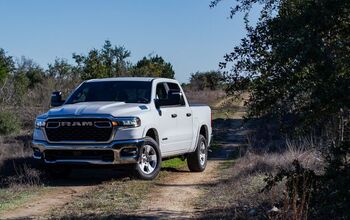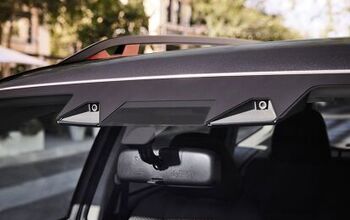Official: 2011 Mustang GT Debuts With 412-hp, 5.0-Liter V8

It’s official: after several broken embargoes, Ford has officially released all the details on the new 2011 Mustang GT. The return of the 5.0-liter brings with it 412-hp at 6500 rpm and 390 ft-lbs of torque at 4250 rpm, a far cry from the 175-hp 302 cubic inch motor found in the 1983 model.
The new engine is an all aluminum unit with four valves per cylinder and dual overhead cams and gets Ti-VCT variable independent timing on both the intake and exhaust cams. Along with all that power, the 2011 GT model also (finally) gets a six-speed manual transmission or six-speed automatic. Not only does this allow for improved performance, but also fuel economy with Ford claiming a four to five percent increase in that department for an estimated 25 mpg on the highway and 17 mpg in the city, up from 23/17 on the current GT automatic model. Manual transmission models will get 24/16 mpg (highway/city)
Other engine highlights include a forged steel crankshaft and high-flow headers that Ford claims are what enthusiasts have always wanted.
Additional vehicle highlights include electric power steering, 11.5-inch front and 11.8-inch rear brakes, as well as a grade-assist feature that will hold the car momentarily when accelerating away from a stop on a hill. Added improvements were made to the rear lower control arms for improved stiffness and more direct handling, a stiffer rear sway bar delivers better on-center steering, while the spring and shock rates have been adjusted for optimal performance.
A Performance Package will include 14-inch Brembo front brake disks from the Shelby GT500 as well as special 19-inch wheels and high performance summer tires.
GALLERY: 2011 Mustang GT
Full technical specs and official release after the jump:
2011 FORD MUSTANG GT
TECHNICAL SPECIFICATIONS
DRIVETRAIN
Layout Rear-wheel drive (Limited slip differential)
TRANSMISSION
Standard 6-speed manual
Gear ratios
1st 3.66
2nd 2.43
3rd 1.69
4th 1.32
5th 1.00
6th 0.65
Final drive 3.31:1
BODY
Construction: Unitized welded steel body, aluminum hood
Final assembly location: Flat Rock, Michigan
POWERTRAIN AND CHASSIS
ENGINE V-8
Type 5.0L 4V Ti-VCT V-8
Manufacturing location TBA
Configuration Aluminum block and heads
Intake manifold Composite shell-welded with runner pack
Exhaust manifold Stainless steel tubular headers
Redline 7,000 rpm (est.)
Valvetrain DOHC, 4 valves per cylinder, variable intake, variable camshaft timing
Valve diameter/lift (mm) Intake: 37/12; Exhaust: 31/11
Pistons Cast aluminum
Connecting rods Forged steel
Ignition High-energy coil-on-plug
Bore x stroke 3.63 in x 3.65 in/92.2 mm x 92.7 mm
Displacement 302 cu. in./4,951 cc
Compression ratio 11.0:1 (est.)
Engine control system PCM
Horsepower 412 @ 6,500 rpm (est.)
Horsepower per liter 82.4
Torque 390 lb.-ft. @ 4,250 rpm (est.)
Recommended fuel 91 octane (unleaded 87 octane minimum)
Fuel capacity 16 gallons
Fuel delivery Sequential mechanical returnless
Oil capacity 8 quarts with filter (10,000-mile service interval)
2011 FORD MUSTANG GT
TECHNICAL SPECIFICATIONS
Optional 6-speed automatic
Gear ratios
1st 4.17
2nd 2.34
3rd 1.52
4th 1.14
5th 0.87
6th 0.69
Final drive 3.15:1
SUSPENSION
Front Reverse-L independent MacPherson strut, 34.6-mm tubular stabilizer bar
Rear 3-link solid (limited slip) axle with coil springs
and Panhard rod and 44.0-mm solid stabilizer bar
STEERING
Type Electric Power Assist Steering (EPAS) with rack-and-pinion gear
Ratio 15.8:1
Turning circle curb-to-curb 33.4 ft. (est.)
BRAKES
Type Four-wheel power disc brakes with 4-sensor,
4-channel anti-lock braking system (ABS)
Front 336 (13.2 in) x 36 mm vented discs,
twin-piston 43-mm floating aluminum calipers
Rear
300 (11.8 in) x 19 mm vented discs,
single-piston 43-mm floating iron calipers
TIRE AND WHEELS (TYPE, SIZE)
Standard P235/50R-18 all-season
18 x 8.0-inch wide spoke painted aluminum wheels
Standard aluminum wheel mini-spare
Optional 18 x 8.5-inch premium painted aluminum wheels
19 x8.5-inch machined face with painted spoke aluminum wheels
18 x8.0-inch sterling gray metallic painted aluminum wheels (MCAS Edition)
19 x8.5-inch machined face with argent painted aluminum wheels (GT/CS)
19 x9.0-inch dark-stainless premium painted aluminum wheels
(Brembo Brake Package)
DIMENSIONS (inches unless otherwise noted)
Coupe Convertible
EXTERIOR
Wheelbase 107.1 107.1
Overall length 188.1 188.1
Overall width 73.9 73.9
Overall height 55.8 55.8
Track, front/rear 62.3/62.9 62.0/62.9
2011 FORD MUSTANG GT
TECHNICAL SPECIFICATIONS
INTERIOR
Seating capacity 4 4
Front headroom 38.5 38.8
Front legroom 42.4 42.4
Front shoulder room 55.3 55.3
Front hip room 53.4 53.4
Rear headroom 34.7 36.5
Rear legroom 29.8 29.8
Rear shoulder room 51.6 45.0
Rear hip room 46.8 45.2
WEIGHTS AND CAPACITIES
SAE passenger volume 83.3 cu. ft. 81.0 cu. ft.
Cargo volume 13.4 cu. ft. 9.6 cu. ft.
Maximum towing capacity
(properly equipped)
1,000 lbs. 1,000 lbs.
FUEL ECONOMY (city/hwy) 6-speed Automatic 6-speed Manual
5.0L 4V Ti-VCT V-8 17/25 (est.) 16/24 (est.)
BASE CURB WEIGHT (POUNDS)
Manual transmission 3,875 (est.) 4,000 (est.)
Automatic transmission 4,000 (est.) 4,000 (est.)
Weight distribution (f/r) 54/46 (est.) 54/46 (est.)
Specifications subject to change without prior notification
THE 5.0-LITER IS BACK: 2011 FORD MUSTANG GT LEADS CLASS WITH 412 HP, FUEL EFFICIENCY, CHASSIS DYNAMICS
The New 2011 Mustang GT 5.0L
Click here to download related images.
* The new Mustang GT continues Ford’s powertrain offensive with an all-new 5.0-liter V-8, which uses advanced technology to deliver 412 horsepower and projected unsurpassed highway mileage of 25 mpg
* For 2011, Mustang GT adds specially tuned Electric Power Assist Steering (EPAS), 11.5-inch front and 11.8-inch rear vented disc brakes, and an enhanced suspension featuring an improved rear lower control arm and stiffened rear stabilizer bushings
* For enthusiasts, a Brembo brake package, with larger rotors and calipers from the Ford Shelby GT500® Mustang, unique 19-inch wheels and summer performance tires, is offered; new fender badges herald return of the 5.0-liter engine
NEW 2011 MUSTANG MEDIA SITE
DEARBORN, Mich., Dec. 28, 2009 – The 5.0 is back! The 2011 Ford Mustang GT arrives with an all-new advanced 5.0-liter V-8 engine, developed by a passionate cadre of enthusiastic engineers who rallied around the common goal of delivering more than 400 horsepower.
The modern 5.0-liter four-valve Twin Independent Variable Camshaft Timing (Ti-VCT) V-8 engine in the new Mustang GT will deliver 412 horsepower and 390 ft.-lb. of torque. At the same time, fuel economy is projected to be better than the previous model and unsurpassed in the segment.
“This all-new 5.0-liter engine is the next chapter in the development of the world-class Mustang powertrain portfolio,” said Derrick Kuzak, group vice president, Global Product Development. “It’s a thoroughly modern engine for the times, delivering the performance and fun-to-drive factor that enthusiasts want, while improving fuel economy.”
Coyote in the lobby
Many of the engineers on the development team have worked in the Engine and Electrical Engineering Building on the Dearborn, Mich., product development center campus. For years they walked past the original 5.0-liter V-8 Coyote Indy racing engine on display in the lobby, continually inspired by its mix of heritage, high technology and horsepower.
The powertrain development community had long wanted to develop a new 5.0-liter powertrain, with strategic discussions beginning in 2000. By 2007, the Mustang competitive landscape was beginning to change, a sign that the time was right for advancing the Mustang GT powertrain to world-class levels.
The team began 5.0-liter engine development with the objective of delivering 400-plus horsepower, on a timetable accelerated by 12 months without compromises in reliability, durability, fuel economy, or noise, vibration and harshness (NVH) control.
“Nearly all of the team members have worked on other high-profile powertrain programs,” said V-8 Engine Programs Manager Mike Harrison. “They all had a clear vision of the work required on their particular component or subsystem. Their passion for engines, racing and delivering every last ounce of performance throughout the engine speed range really demonstrated that they put their heads and their hearts into this powertrain.”
Development test engines and benchmarks included 5.0-liter blocks, employing different bore and stroke measurements, GT500 four-valve-per-cylinder heads and cams, various intake manifold runner configurations, differing compression ratios and a deep-sump oil pan. The team also evaluated Ford Racing’s 5.0-liter “Cammer” V-8 crate engine for transferable best practices.
Extensive computer-aided engineering (CAE) modeling, development engine experimentation and evaluation in combination with intricate machine work brought this promising, all-new configuration to jaw-dropping life in an accelerated time frame.
The result of this development is an “and” solution, not an “or.” 2011 Mustang buyers will enjoy the benefits of a powerful engine as well as responsible fuel economy.
Ti-VCT
A critical element in the 5.0-liter V-8’s ability to deliver 412 horsepower, with improved drivability, tractability and fuel economy over the 2010 Mustang GT powertrain, is enhanced Ti-VCT.
For a high-performance application, the team specified cam-torque-actuated variable camshaft timing. Using existing cam torque energy, with assistance from pressurized oil, meant that minimal upgrades to the oil pump were required, resulting in less parasitic drag. Increased volumetric and thermal efficiency gives faster Ti-VCT response at all engine speeds.
During the development phase, camshaft lift profile and port optimization started with higher-lift Ford Racing aftermarket units, modified for compatibility with various four-valve-per-cylinder heads. Extensive CAE and dynamometer testing was performed to fine-tune camshaft events and port flow for performance and fuel efficiency in conjunction with the variable camshaft timing.
The resulting all-new aluminum four-valve-per-cylinder heads feature a compact roller finger follower valvetrain layout leaving more room for high-flow ports for free-breathing performance. Head structure was designed to support higher cylinder head pressures and cross-flow cooling for sustained high-rpm use. Head bolt size was increased from 11 to 12 millimeters to contain the higher combustion pressures.
The aluminum block was developed for optimized windage and oil drainback under lateral conditions and high rpm, such as a track-day outing for an enthusiastic owner and driver. Increased main bearing bulkhead widths and nodular iron cross-bolted main bearing caps with upsized bolts were also employed to accommodate the significant performance increase.
An additional element is the increased capacity and baffling of the deep-sump stamped steel oil pan to enable sustained high-rpm use and offer the convenience of 10,000-mile oil change intervals. Piston-cooling jets also were incorporated for performance-minded customers and for faster oil warm-up on cold start.
Specially designed tubular exhaust headers were developed to maximize exhaust pulse separation and improve flow. A team analyst actually fabricated the tubular headers in his home workshop, bringing the CAE design to life.
Performance and fuel economy
The 412 horsepower and 390 ft.-lb. of torque delivered by the 2011 Mustang GT 5.0-liter V-8 represent significant increases versus the 2010 model year output levels.
The six-speed automatic transmission on the 2011 Mustang GT will deliver up to an estimated 25 mpg highway and 17 in the city. This is up from 23 mpg highway and 17 city for the 2010 model. Six-speed manual transmission Mustang GT models for 2011 are projected to deliver 24 mpg highway and 16 city, matching the 2010 model but delivering significantly more horsepower and performance feel.
2011 Mustang GT fuel economy is enabled by the Ti-VCT, the six-speed transmissions in automatic or manual variations, EPAS and an additional rear decklid seal to enhance aerodynamics.
Fuel economy also is aided by engineering a lightweight powertrain. The engine, as shipped, weighs just 430 pounds. This represents a weight savings of more than 20 percent versus the previous 5.0-liter offering. Lower mass can be attributed to the aluminum block and heads, the lightweight composite intake manifold, composite cam covers and hollow camshafts.
Improved driving dynamics
EPAS has made a dramatic contribution to Mustang GT driving dynamics, delivering quicker on-center steering response, increased effort at highway speeds and reduced effort required in low-speed parking maneuvers. EPAS allows specific tuning for the Mustang GT application.
The 2011 Mustang GT features an enhanced rear lower control arm to add stiffness, improve powertrain NVH control and sharpen handling. A stiffened rear stabilizer bar for better on-center steering is also included. Stabilizer bar diameters, spring rates and dampers all have been tuned for improved dynamics.
A Brembo brake package upgrade will be available for serious enthusiasts. This package includes 14-inch vented front discs from the GT500 Mustang, unique 19-inch alloy wheels and summer performance tires.
Added convenience content
For 2011, Mustang GT offers drivers several new convenience technologies, including:
* Standard message center
* Integrated blind spot mirrors
* MyKey™ programmable vehicle key
* Illuminated visors
* Universal garage door opener
* Sun visor storage
New look
From the 5.0 fender badges to the new engine cover, Mustang GT honors and continues the proud heritage of its predecessors. The speedometer increases to 160 mph and the tachometer redline advances from 6,500 to 7,000 rpm.
Three vibrant new colors will be added for 2011 including Yellow Blaze Tri-Coat, Race Red and Ingot Silver.
Improved NVH control and convertible rigidity
For 2011, Mustang GT benefits from across-the-board NVH improvements. These include additional sound-deadening material on either side of the instrument panel, an additional seal between door and rocker panel to reduce wind noise and a real wheel arch liner to reduce noise on gravel or wet surfaces.
Mustang GT convertible models feature enhanced structural rigidity, with lateral stiffness improved by 12 percent versus the 2010 model. A tower-to-tower front strut brace is now standard, and the V-brace has been stiffened by adding gussets. The secondary crossmember also has been stiffened while a front Z-brace has been added, connecting primary and secondary crossmembers. A-pillar stiffening foam also has been added to increase rigidity.
“This powertrain honors Mustang’s heritage by raising the bar on performance while increasing fuel economy,” said Barb Samardzich, vice president, Powertrain Development. “For enthusiasts, such as the passionate members of the 5.0-liter V-8 team, it’s like having your cake and eating it, too.”

With AutoGuide from its launch, Colum previously acted as Editor-in-Chief of Modified Luxury & Exotics magazine where he became a certifiable car snob driving supercars like the Koenigsegg CCX and racing down the autobahn in anything over 500 hp. He has won numerous automotive journalism awards including the Best Video Journalism Award in 2014 and 2015 from the Automotive Journalists Association of Canada (AJAC). Colum founded Geared Content Studios, VerticalScope's in-house branded content division and works to find ways to integrate brands organically into content.
More by Colum Wood































Comments
Join the conversation
I had a 1995 5.0 It was a great car to tinker with. I am so glad that Ford has brought back 5.0 in such a SOLID setup. I went to A Nissan 350Z a few years ago. The Z is a great looking car, but I miss the natural muscle of my old 5.0... I hope and pray that FORD puts this motor in a two seater type Z car. I WOULD PAWN THE FARM FOR SOMETHING LIKE THAT!!!
just bought 2011 gt .. I am a true chevy man . I have 1969 camaro / 1999 sts caddy and 2006 escalade ..and a 1971 chevelle ss.. I TEST DROVE THE CAMARO AND COULD NOT WAIT TO ORDER ONE . But I held out waiting for the 5.0 i'm glad i did . first thing i did was chang the exhaust. What a differance then put in the roush cold intake pushing more ponies..I must say ford did their homework on this car.. I see nothing but dodge and chevy in my reveiw mirror.. GREAT JOB FORD........